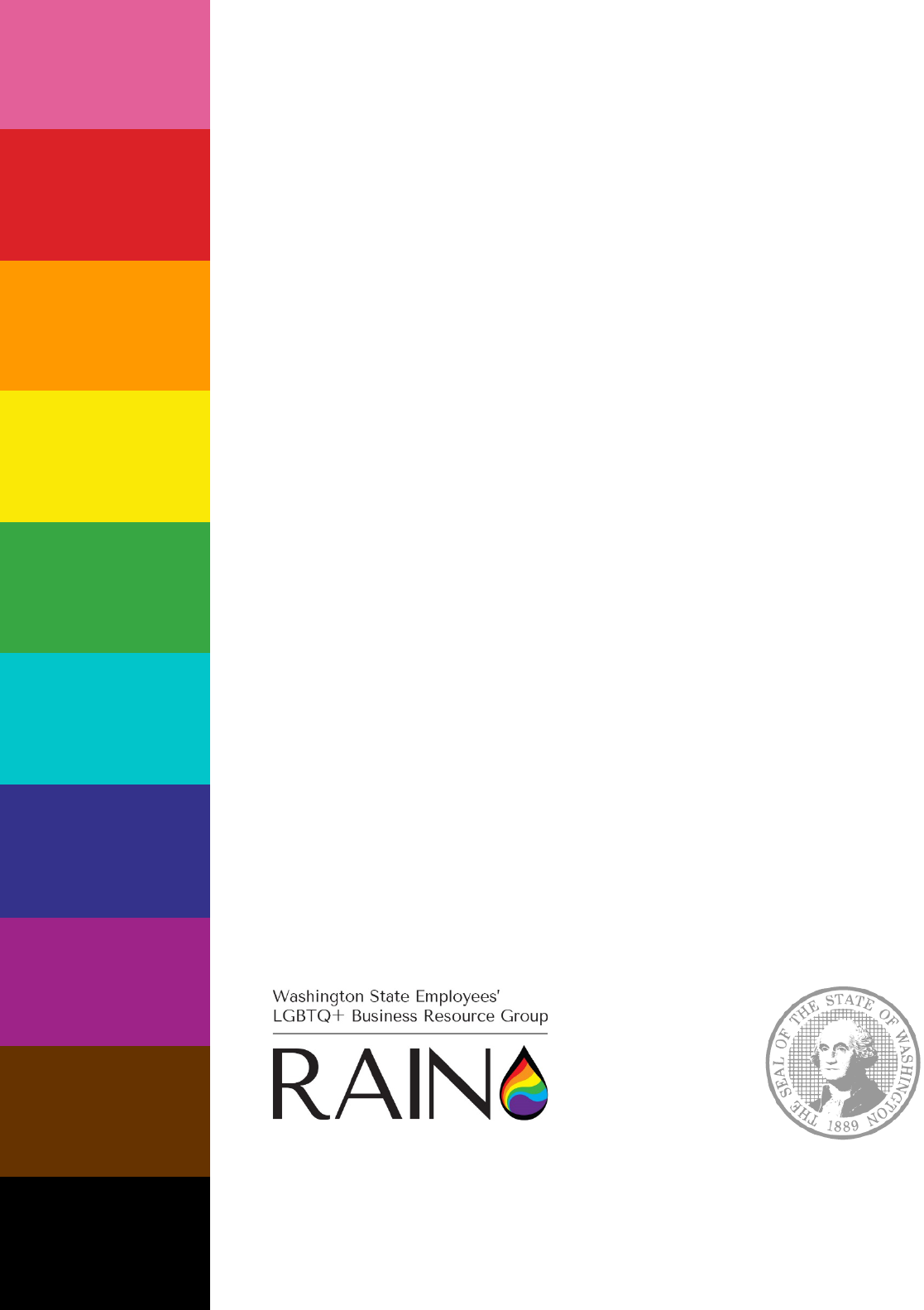
Inclusive Bathroom
Signage Recommendations
By the Rainbow Alliance Inclusion Network
Best Practices Subcommittee
State Human Resources
Office of Financial Management
July 2019
Table of Contents
Executive summary .................................................................................. 1
Background ......................................................................................................... 1
Recommendations .............................................................................................. 2
Washington state ....................................................................................... 3
Employer of choice .................................................................................. 4
The business case ..................................................................................... 4
Case studies ................................................................................................ 5
Office of Financial Management, State Human Resources ......................... 5
Department of Health ....................................................................................... 6
Employment Security Department .................................................................. 7
Interviews .................................................................................................... 8
Anonymous interview 1 .................................................................................... 8
Anonymous interview 2 .................................................................................... 9
Concerns and barriers ............................................................................10
Additional resources ..............................................................................11
Agency example documents ................................................................12
DOH Stakeholder Analysis and Decision Paper for Bathroom
Inclusivity Project. ............................................................................................ 12
Bathroom Signs Decision Paper .................................................................... 15

1
Executive summary
This document produced by the Best Practices Group, a subcommittee of the Rainbow Alliance
Inclusion Network, or RAIN, explores the role of updating restroom signage in promoting gender
inclusivity in the workplace. While some state agencies have created gender-affirming restroom signs
and gender nonrestrictive single-stall restrooms, many have not. This document is meant to assist
state agencies considering new bathroom signage in making their own improvements by explaining
why agencies have made this change, the challenges agency leaders faced in adopting the new
signage and how each agency ultimately overcame those challenges.
The full document also includes individual testimonials from LGBTQ+ state employees and the
personal impact that inclusive restroom signs have had on their ability to show up authentically at
work.
Taken together, this information offers agency leaders a clearer view of how important a simple
change like updating restroom signage can be and a framework for leading their agency through
signage changes.
Background
Nationally, polling data collected by Gallup shows there has been a steady increase in the percentage
of U.S. adults who identify as lesbian, gay, bisexual or transgender (LGBT
1
) from 3.5% in 2012 to
4.5% in 2017.
2
The Pacific region of the United States saw the greatest increase in LGBT identification, from 4.2%
in 2012–13 to 4.9% percent in 2015–16.
And in Washington, Gallup polling shows that 4.6% of adults identified as LGBT in 2015–16.
3
The 2015 National Transgender Survey found that 23% of trans people in Washington state who had
held a job in the previous year reported being mistreated at work based on their gender identity or
gender expression. This mistreatment included employees being forced to use a restroom that did not
align with their gender identity.
4
Despite Washington Administrative Code 162-32-060 that states that all covered entities “cannot
require use [of restrooms] inconsistent with gender expression or gender identity,” misinformation
and mistreatment persist. The use of gender-inclusive and gender- affirming signage on agency
restrooms not only affirms compliance with this law, but allows agencies to reaffirm their
commitment to diversity, equity, inclusion and respect.
1
LGBTQ+ is an acronym used for lesbian, gay, bisexual, transgender and queer. The plus sign is used to include individuals who are not listed
(pansexual, agender, bigender, two-spirit, etc.) While there are other forms of this term in use, this report uses LGBTQ+ without intending to
exclude any individuals.
2
Frank Newport. (2018). In U.S., Estimate of LGBT Population Rises to 4.5% Gallup website.
3
Gary J. Gates. (2017). Vermont Leads State in LGBT Identification Gallup website.
4
2015 National Transgender Survey.

2
Recommendations
Based on our research, communication with agency leaders and testimonial accounts from
transgender and non-binary state employees, we recommend that all state agencies take the
following steps:
Develop change management plans
Make single stall restrooms and showers gender nonrestrictive.
Add gender-affirming signage to segregated bathrooms that state people are welcome to use
the restroom that best aligns with their gender identity.
5
This is consistent with WAC 162-
32-060 and RCW 49.60.
Include gender nonrestrictive restroom facilities in all new construction. In cases of
remodels, conversion to nonrestrictive restroom facilities, whenever possible, is
recommended.
When considering the transition of restroom signs to gender-inclusive signage, we recommend
equipping agency leaders, managers and supervisors with as much information as possible at the
start of the process. This includes arming leaders with educational materials, answers to frequently
asked questions and identifying where employees can go outside the agency for assistance. In this
way, staff feel and see t they have supportive leaders who can walk them through these changes.
You may want to follow these steps as you introduce gender-inclusive restrooms and signage:
→ Hold a panel on the topic.
→ Have office hours with HR or agency leadership for individuals to discuss concerns or
questions in real time.
→ Identify, as available, a single stall, gender nonrestrictive restroom for anyone who has
additional need for privacy, regardless of the reason. Incorporate pointing out this restroom
during orientation of new employees.
→ Include stories demystifying the LGBTQ+ community in agency publications, newsletters
and intranet articles.
→ Encourage your employees to attend RAIN general membership meetings, and for those
who are interested, to participate in subcommittee work.
→ Develop, promote and support an internal agency LGBTQ+ affinity group.
5
Although these recommendation are inclusive of LGBTQ+ employees and customers, we urge you to consider all your employees and make
the signs as accessible as possible. This can include adding Braille and raised letters and selecting inclusive images.

3
Washington state
Nationally, polling data collected by Gallup shows there has been a steady increase in the percentage
of U.S. adults who identify as lesbian, gay, bisexual or transgender, or LGBT, from 3.5% in 2012 to
4.5% in 2017.
6
Percentage of U.S. adults identifying as LGBT
has been steadily increasing over past 6 years.
The Pacific Region of the United States (Alaska, Washington, Oregon, California, Hawaii and Alaska)
saw the greatest increase in LGBT identification, from 4.2% percent in 2012–13 to 4.9% in 2015–16.
In Washington, Gallup polling showed that 4.6% percent of adults identified as LGBT during the
same time period.
7
While the increase in adults identifying as LGBTQ+ grows, there continues to be risk in the
disclosure of membership in the LGBTQ+ community. Discrimination and violence against the
LGBTQ+ community persists despite some progress.
According to the Human Rights Campaign, 21 states prohibit discrimination in housing and
employment based on both sexual orientation and gender identity. Additionally, 18 states address hate
or bias crimes based on sexual orientation and gender identity.
8
The FBI’s 2016 hate crime statistics showed an increase in violence against the LGBTQ+
community. According to data voluntarily reported to the FBI by various law enforcement agencies
across the country, 6,121 hate crime incidents against the LGBTQ+ community occurred in 2016.
Analysis from the Human Rights Campaign showed this represents an increase of 5% from 2015.
9
6
Frank Newport. (2018). In U.S., Estimate of LGBT Population Rises to 4.5% Gallup website.
7
Gary J. Gates. (2017). Vermont Leads State in LGBT Identification Gallup website.
8
Human Rights Campaign. State Maps of Laws and Policies. Accessed September 6, 2018.
9
Human Rights Campaign. New FBI Data Shows Increased Reported Incidents Anti-LGBTQ Hate Crimes in 2016. Accessed September 6,
2018.
3.5
3.6
3.7
3.9
4.1
4.5
2012 2013 2014 2015 2016 2017
Percent of Population

4
Employer of choice
On June 23, 2016, Gov. Jay Inslee issued Directive 16–11: The LGBTQ+ Inclusion and Safe Places
Initiative. Its purpose was to advance the state’s goal of diversity and inclusion, and to reiterate that,
“[e]very person in the state of Washington has the right to feel safe, enjoy the benefits of public
services, and fully participate in civic life.”
In this directive, Inslee laid out three priorities:
The development of an LGTBQ+ Employee Resource Group
10
The development of a best practices group
The development of a safe place program
The LGBTQ+ Employee Resource Group, later referred to as the Rainbow Alliance Inclusion
Network, or RAIN Business Resource Group, was launched in January 2017. The Best Practices
Group started at the same time as a RAIN subcommittee. Its goal is to research and establish best
practices to make Washington state an employer of choice and a safe place for LGBTQ+ employees
to work (see charter).
Responses from a survey of RAIN members identified gender-inclusive signage as a top priority in
achieving this goal.
The business case
According to the U.S. Bureau of Labor Statistics, by the year 2025 millennials will compose 75% of
the workforce. Many millennials are foreign-born, biracial or LGBTQ+ and they define diversity
differently from previous generations. For them, diversity is an individual mix of unique experiences,
identities, ideas and opinions more so than any single trait.
According to Deloitte, diversity and inclusion lead to better business performance. “When
employees think their organization is committed to, and supportive of diversity and they feel
included, employees report better business performance in terms of ability to innovate, (83%)
responsiveness to changing customer needs (31%) and team collaboration (42%).”
11
Changing restroom signs to be more inclusive of people’s gender identity is one opportunity to
support LGBTQ+ staff and may help state government retain diverse, top talent.
10
Employee resource groups that are staffed by Office of Financial Management’s State Human Resource employees are now referred to as
business resource groups, or BRGs, due to the tie to a business need.
11
Deloitte. (2013) Waiter, is that Inclusion in my Soup? Accessed June 27, 2019.
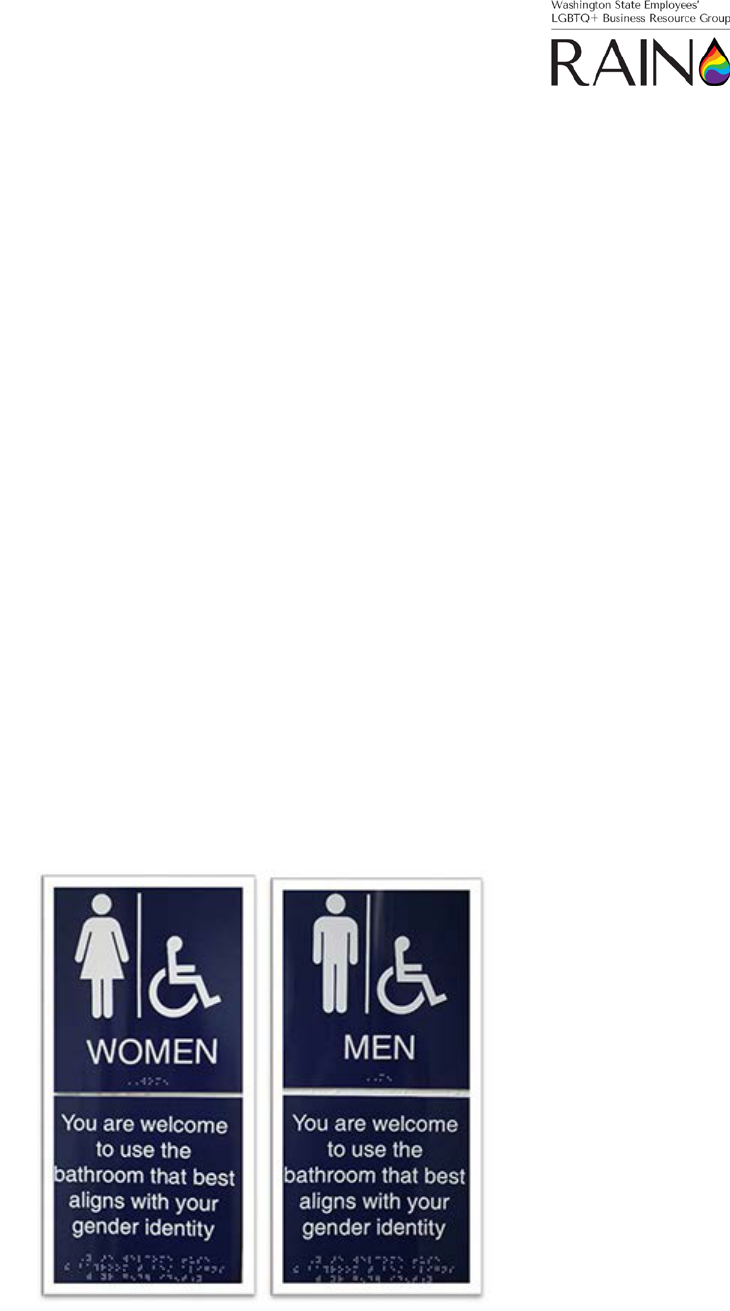
5
Case studies
Several state agencies have changed or are in the process of changing bathroom signage. Their
experience may provide insight on the process, outcomes, barriers and concerns that arose during
their transition to gender-inclusive signage.
Office of Financial Management, State Human Resources
The assistant director of State Human Resources decided to update signage at the State HR offices
housed in OFM. This decision was based on recommendations made during a presentation covering
basic LGBTQ+ vocabulary and other LGBTQ+ resources on Gov. Inslee’s Directive 16-11.
Proposal: The original proposal consisted of five recommendations; two were specific to restroom
signage:
To add gender-affirming signs to multi-stall restrooms.
To remove gender-restricting signs from single use showers and restrooms.
Steps taken: Educational materials were provided to employees at a regular staff meeting. Leadership
reaffirmed that the changes aligned with the values of the organization, including OFM as an
employer of choice and as a respectful, diverse and inclusive employer. Employees were encouraged
to reach out to the Employee Assistance Program, OFM, State HR or management with questions
or concerns.
To date: Single occupancy individual shower restrooms were designated as gender nonrestrictive. All
multi-stall restrooms have gender affirming signage that reads “You are welcome to use the
restroom that best aligns with your gender identity.”
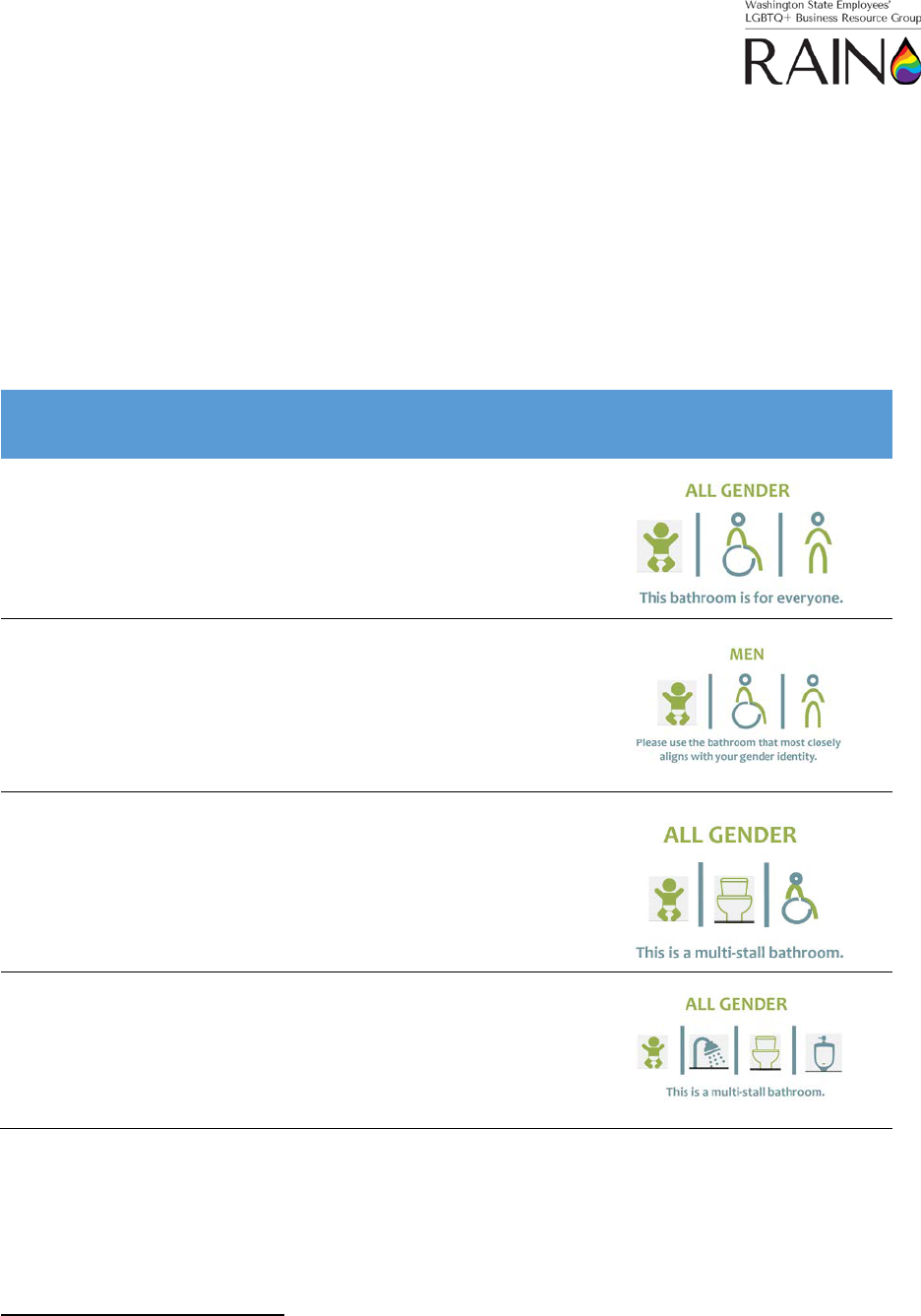
6
Department of Health
A Department of Health work group recently proposed to its leadership updating signage of
bathrooms to address feelings of safety and dis/comfort when using restrooms.
12
The proposed change was designed over four stages, with a recommendation that all stages be
implemented over a period of time determined by leadership and to schedule six-month assessments
on progress by the work group.
Proposed language/look for signs:
Type of
Bathroom
Language for signs Look of signs
Single stall
With or without “All Gender” at the top
“This bathroom is for everyone” added at
the bottom of sign
Gender neutral figures
Multi-stall
segregated
“Men” or “Women” at the top
“Please use the bathroom that most
closely aligns with your gender identity”
added below
Gender neutral figures
Multi-stall
(no showers)
integrated
“All Gender” at the top
“This is a multi-stall bathroom”
Gender neutral figures
Image of a toilet
Multi-stall
(with showers)
integrated
“All Gender” at the top
“This is a multi-stall bathroom”
Gender neutral figures
Image of a shower, toilet and urinal
Stages proposed:
Stage 1: Add gender-neutral signage on all single-stall bathrooms.
Stage 2: Add gender-neutral language to signage on all bathrooms.
Stage 3: Convert bathrooms that have stalls and no showers to gender neutral.
12
This information was collected from DOH in the fall of 2018. Information and processes may have changed. For the most up-to-date
information regarding this change, please contact DOH’s Human Resources office.
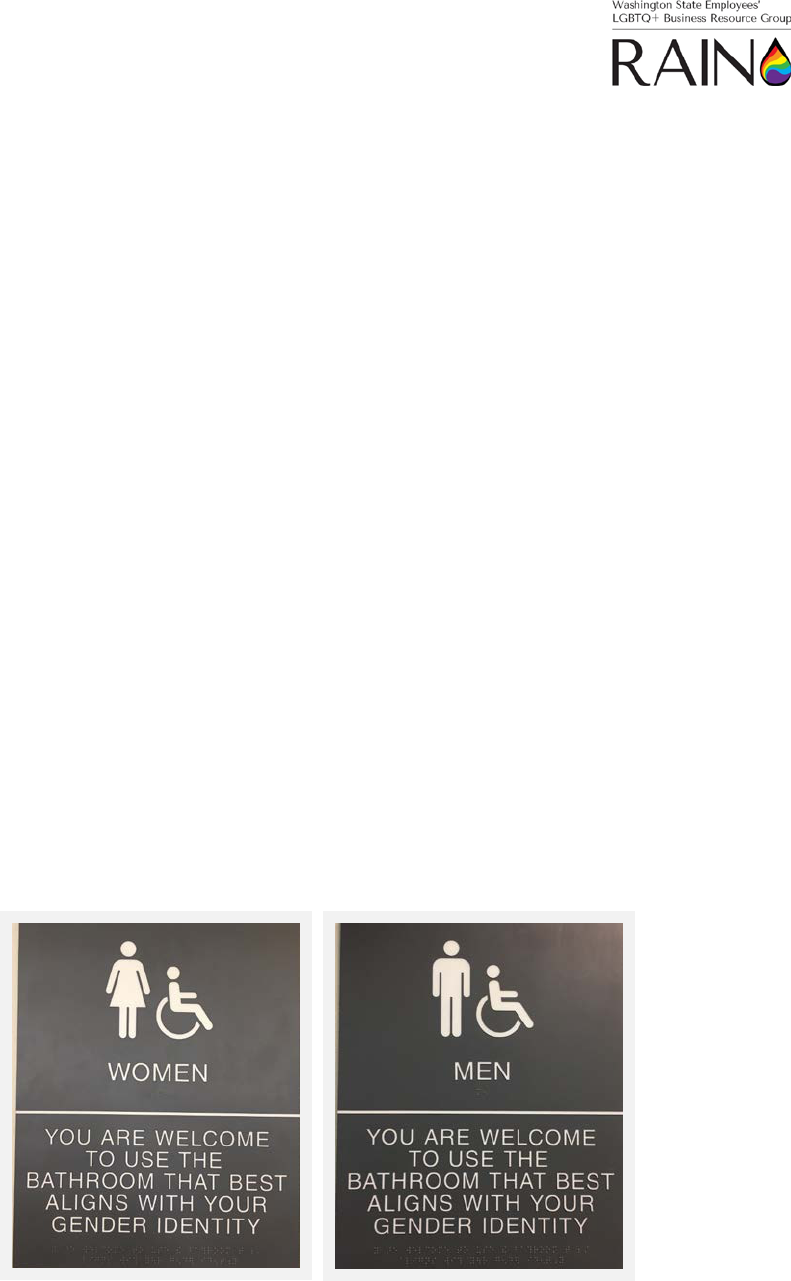
7
Stage 4: Convert bathrooms that have stalls and showers to gender neutral.
Steps taken: The DOH Diversity Committee and agency leadership looked at stages of
implementation, conducted a stakeholder analysis (Appendix A) and designed a PowerPoint
presentation with proposed signage that was shared with staff.
To date: Stage 1 has been implemented. Discussion on the other stages continues.
Employment Security Department
The commissioner asked about gender neutral bathrooms in ESD which started the conversation on
bathrooms and signage. Knowing that other agencies had started the process of putting up gender
affirming signs, ESD’s equal opportunity and diversity manager reached out to OFM about the steps
it had taken.
ESD proposed to add gender-affirming language to the restroom signs, starting with the Maple Park
building.
Steps taken: A communication plan was put together. Executive leadership was trained on gender
identity and given the plan to update signs. All supervisors were trained on gender identity. Two
lunch-and-learn panels were held on gender in the workplace. Emails updated staff. The gender
training was open up to all agency employees, not just managers. The equal opportunity manager
held open office hours before and after each training and additional office hours when time
permitted for anyone to come ask questions or voice concerns. Written resources were provided.
To date: All multi-stall restrooms in ESD’s Maple Park building have gender-affirming signage that
reads, “You are welcome to use the bathroom that best aligns with your gender identity.”

8
Interviews
The interviews below were gathered to give agencies an idea of the impact and effects of having
gendered restrooms on LGBTQ+ employees. Due to the sensitive nature of the topic, steps were
taken to protect individual identities. This included having the individuals give their stories verbally
and the answers transcribed by members of the Best Practice Group. Once transcribed, each
individual was able to review and confirm that what was transcribed was an accurate representation
of what they said. Because of this, the interviews are written in the form of questions and answers,
and are from the perspective of the transcriber.
Anonymous interview 1
The experience in this interview is from a transgender woman working in a large Washington state
agency.
What is your experience using the restroom without gender-inclusive improvements?
Using the restroom was especially difficult for her at the beginning of transitioning. There is no
gender-neutral restroom option in her work building. Fear and anxiety cause delay in using the
restroom. She then questions if her anxiety is based on reality. She drinks little water to minimize
the need for the restroom during work. When she does use the restroom, she mentioned that it is
like going on a recon mission.
She has rules she repeats in her mind:
No talking
Leave space between herself and others (if there are three stalls and someone is in the first,
go to the third).
Every time she walks into the restroom there is fear. Her heart beats fast and she becomes
hyperaware. She says it causes her to hold her breath, to feel like she is walking on eggshells. She
says that it is not healthy and is mentally taxing.
Using the restroom in all public places is hard and scary for her because she does not know people.
She always has to think before going out.
What could have been helpful for you along the way?
All single stall, general use in the same space would be best, but realistically having one gender-
neutral bathroom would allow her to use the restroom in peace, without looking over her shoulder.
Also, not compromise her professional career due to bathroom use. Getting asked what bathroom
you use is not something a cisgender
13
person encounters.
Other things that would help her are opportunities to build relationships with coworkers, and having
different facilities pointed out on a new-employee tour of the building.
13
A person whose gender identity and sex assigned at birth align.

9
What would change for you if gender-affirming signs were added to the bathrooms?
It would be an immediate sign that the agency was taking steps to be inclusive and the
agency/authority figures have her back. The signs would help her coworkers better understand, and
make cisgender colleagues aware too. The signs would also let her know her agency is trying to be a
safe place.
Anonymous interview 2
The experience in this testimonial is from a genderqueer
14
individual working in a large state agency.
What is your experience using the restroom without gender-inclusive improvements?
Using the restroom for them is an anxiety-driven experience. There is no gender nonrestrictive
bathrooms in their building. When they have to use the restroom, they use the restroom that makes
them feel safest, safety always being the focus.
When they first started working in their agency, they would hold their bladder as long as possible
and try to avoid drinking any water for extended periods of time. When they did have to use the
restroom, they approached the situation cautiously and quickly.
They mentioned how every time they walked into the restroom their face get hot, and it would feel
as if sound was magnified. They made sure to look down and rush into the stall.
Over time, and after building relationships with their coworkers and management, they have become
more comfortable using the restroom in their agency. A contributing factor to them feeling
comfortable was the openness and support of their coworkers and management. Their management
put pronouns in their signature lines and talk about diversity, equity and inclusion as an ongoing
conversation. As a group they have taken trainings on diversity and LGBTQ+Q+ specific topics.
Their management also added diversity, equity and inclusion to their strategic plan to better help
customers. They feel these actions have established a safe environment for them to bring their true
self to work every day. As a result, they no longer restrict their water drinking and use the restroom
when they need to.
However, no matter how comfortable they become, they still have underlying fear and anxiety.
What could have been helpful for you along the way?
The most helpful thing would be gender nonrestrictive bathrooms available in every building.
Realistically though, the people around them are the most helpful. The people they work with have
taken steps to create an environment that is safe, where they are able to use the restroom with less
fear and anxiety because they know that they have support. The comfort of knowing they have an
ally, or in this case multiple allies, has been the most helpful thing.
14
Someone who does not identify within the conventional gender binary of a man or woman. For people who identify outside of the binary the
pronoun “them” is used.

10
What would change for you if gender-affirming signs were added to the bathrooms?
They would not change which bathroom they used. Instead they would use the same restroom but
with slightly more comfort knowing that someone who has enough authority to make those
decisions has put thought and energy into adding the signs. It does not change their action, but it
does let them know someone sees and cares about them.
Concerns and barriers
Employees and customers alike need restrooms. By adding gender-affirming language to signs,
agencies are taking steps to provide equal access to everyone.
It should be noted that while concerns have been raised, agencies that have implemented new
signage have done so largely without conflict.
These concerns fell mainly into two categories:
• Personal and religious beliefs
• Individuals falsely claiming to be a specific gender to access the restroom for inappropriate
reasons
While some individuals expressed concern, discomfort and fear about changing the signage for
restrooms, this was largely due to misinformation that updating signs would somehow change
restroom norms or usage. In general, these concerns were addressed and fears allayed by explaining
the intent of this work (inclusion) and the desired outcome (supporting all employees). In response
to individuals’ concerns, one agency purchased inserts for the gaps between stalls in its restrooms.
Similarly, one agency had employees raise concerns about if they walked into a restroom, felt
uncomfortable and left to use another facility. Could a discrimination complaint be filed against
them?
Adding gender-affirming language to the sign does not change restroom norms. As always, any
inappropriate behavior in a restroom should be reported and handled accordingly, regardless of the
individual’s gender identity. As stated in WAC 162-32-060, “Any action taken against a person who
is using a restroom or other gender-segregated facility, such as removing a person, should be taken
due to that person’s actions or behavior while in the facility, and must be unrelated to gender
expression or gender identity. The same standards of conduct and behavior must be consistently
applied to all facility users, regardless of gender expression or gender identity.”
In the event someone is uncomfortable using the restroom with someone else based on their gender
identity, the first person should seek a different facility to use. As stated in WAC 162-32-060, “If
another person expresses concern or discomfort about a person who uses a facility that is consistent
with the person’s gender expression or gender identity, the person expressing discomfort should be
directed to a separate or gender-neutral facility, if available.”
Barriers that arose largely related to facilities.
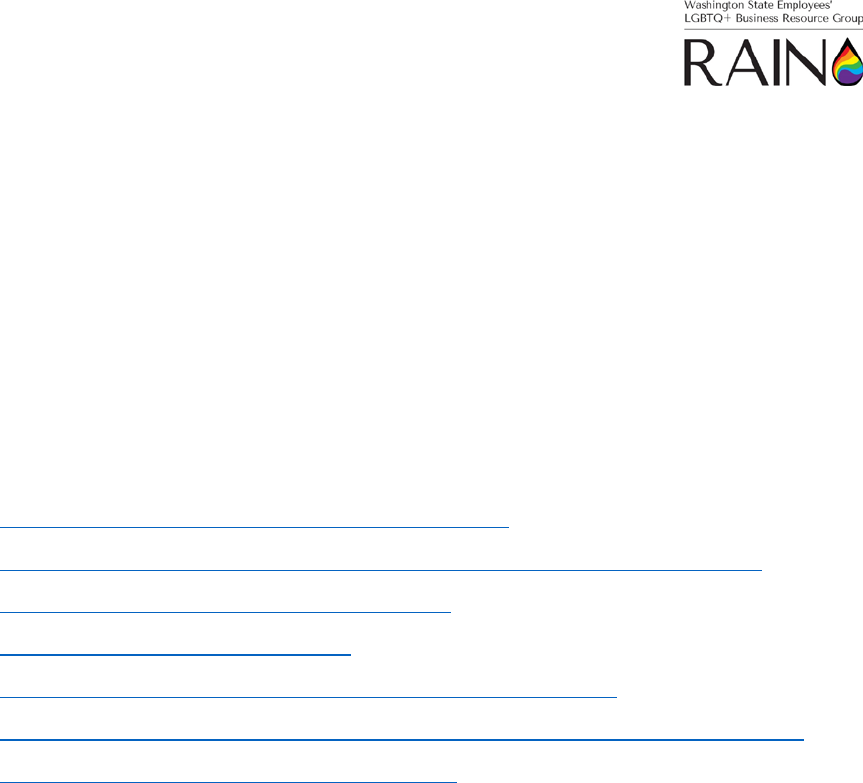
11
New signs with gender-affirming language should be applied to all gendered facilities, not just
bathrooms with stalls. This includes bathrooms with showers and changing areas. As stated in WAC
162-32-060, “All covered entities shall allow individuals the use of gender-segregated facilities, such
as restrooms, locker rooms, dressing rooms, and homeless or emergency shelters, that are consistent
with that individual’s gender expression or gender identity. In such facilities where undressing in the
presence of others occurs, covered entities shall allow access to and use of a facility consistent with
that individual's gender expression or gender identity.”
Agencies should work directly with their building maintenance staff to address tenant/owner issues.
Thus far, building landlords have been very accommodating about updating signage and working
with agencies to achieve the best outcomes possible.
Additional resources
• Washington State Law on Gender Segregated Facilities
• Frequently Asked Questions about WAC 162-32-060 Gender-segregated Facilities
• Transgender People and Bathroom Access FAQ
• 2015 U.S. Transgender Survey Report
• Transgender Inclusion in the Workplace: A Toolkit for Employers
• FAQ: Answers to Some Common Questions about Equal Access to Public Restrooms
• Response to Petition to Repeal WAC 162-32-060

12
Agency example documents
The following are materials that state agencies have used in transitioning to more-inclusive
restrooms.
DOH Stakeholder Analysis and Decision Paper for
Bathroom Inclusivity Project.
Stakeholder Analysis
Stakeholder Interest Impact
level
(Direct,
influence,
affected)
Current
position
(supportive,
neutral,
opposed)
Potential Key Message
Human
Resources
Potential increase in
questions and/or
complaints, employer
of choice (recruitment
and retention as well
as engagement),
addition to new
employee orientation
during tour
Direct Supportive
but cautious
Make sure DOH is employer of
choice, support staff in feeling
they can bring their whole self to
work
DOH
staff/contract
employee/
interns
Being safe and
feeling comfortable
using the bathrooms
Affected;
influence
Supportive,
neutral and
opposed
depending on
staff person
-Going to the bathroom is not a
privilege, but a right.
-Many trans* and gender
nonconforming people will avoid
using the bathroom if not given a
safe or anxiety free option
-Not using the bathroom when
one needs to can cause severe
health problems such as
dehydration, malnutrition, or a UTI
depending on how one deals with
not having a bathroom option.
-We can’t assume there is not a
problem or this only impacts a
small number of individuals.
--This reinforces DOH’s
commitment to diversity and
inclusion
Facilities
(including Safety
and Security)
Physical work
updating signage,
eventually bathrooms
(?); safety/security
Direct Supportive if
agency
agrees to
move forward
This is an opportunity to support
equity at DOH; Importance of
being an inclusive organization so
people feel safe and comfortable.

13
Stakeholder Interest Impact
level
(Direct,
influence,
affected)
Current
position
(supportive,
neutral,
opposed)
Potential Key Message
may have increase in
complaints
Building Owners Physical work could
be done to their
building; we need to
stay within their
lease/guidelines/
Who will pay for it?
What is the cost?
Direct Unknown We will continue to adhere to your
guidelines; we are just doing our
best to make this an inclusive
workplace. Convey information
about the cost as well.
Leadership—
including JOLT
Potential increase in
questions and/or
complaints, employer
of choice (recruitment
and retention as well
as engagement);
making staff feel safe
and comfortable is
using bathrooms;
handling potential
general uproar; would
need to approve
changes
Direct at
every
level/step
of process
Supportive,
neutral and
opposed
depending on
individual
and level of
aggressivene
ss of policy
Provide option(s) to phase the
policy in and convert one or two
bathrooms at a time in each
building after changing signage
on one stall bathroom; This is an
opportunity to support equity at
DOH; Importance of being an
inclusive organization so people
feel safe and comfortable.
Individuals
handling
complaints:
employee
services,
appointing
authorities
(deputies)
and/or labor
relations
Potential increase in
questions and/or
complaints
Direct Should be
neutral in
enforcing
policy; in
reality may
vary
dependent
on situation.
This is DOH’s policy and we all
must adhere to it.
Consumers-
residents of
state
May see a precedent
with which they do or
don’t agree.
Affected
Supportive,
neutral and
opposed
depending on
individual
and level of
aggressivene
ss of policy
DOH is setting a precedent in
being inclusive and
representative of the communities
we serve.
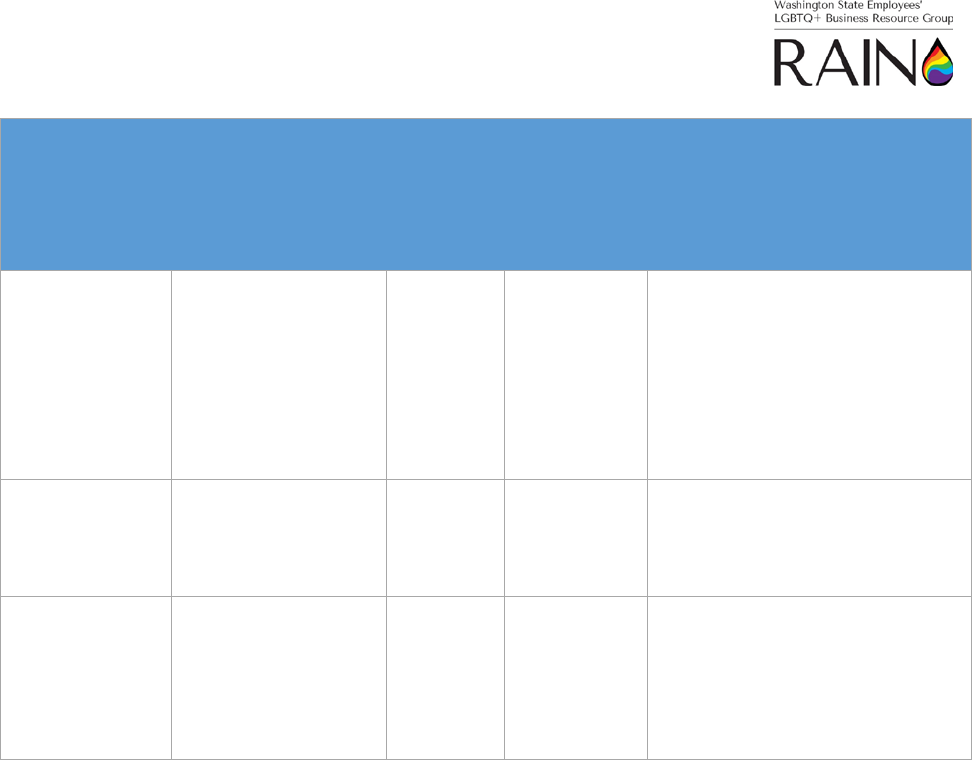
14
Stakeholder Interest Impact
level
(Direct,
influence,
affected)
Current
position
(supportive,
neutral,
opposed)
Potential Key Message
Friends in labor
relations/unions
Bargaining with
unions on potential
impact to employees
Direct Dependent
on reaction of
represented
employees
May be dependent on previous
policies and labor’s reactions;
we’re pushing this forward so all
DOH employees will have the
right to use the bathroom with
which they are comfortable. Right
now, we are not operating in a
way that fulfills everyone’s rights.
Office for Civil
Rights and Risk
Management
(CRRM)
Spearheading the
policy, handling
complaints,
answering questions
Direct Supportive Role: Delivering/crafting
message.
LGBTQ+Q
Business
Resource
Group, Gay City,
Gender Justice
League.
Vetting policy, signs
and messages
Direct Supportive Role:
Providing input as needed on
messaging.

15
Bathroom Signs Decision Paper
DECISION PAPER:
ALL-INCLUSIVE BATHROOMS
Date: 5/9/2018
Person Submitting: Shawn Murinko
Problem Statement: Because our facilities are set up with traditional male/female (“cisgender”)
bathrooms, not everyone at DOH feels comfortable and/or safe accessing the bathroom.
Background: For transgender and gender nonconforming individuals, gender-segregated bathrooms can
be spaces where they are met with intimidation, harassment, and/or violence. Gender segregated
bathrooms threaten the safety of many transgender and gender nonconforming individuals. In addition to
being a safety concern, this bathroom configuration can lead to health concerns. When one does not have
a bathroom option that they feel comfortable and/or safe accessing, they may choose to not use the
bathroom. Avoiding use of the bathroom can cause serious health problems.
Significance: This process will reinforce DOH’s commitment to diversity and inclusion. This is a way to
demonstrate that DOH values everyone, and cares about the health and safety of all.
Key Stakeholders & Interests:
See attached
Stages:
1. All single-stall bathrooms get a gender-neutral sign.
2. Put gender neutral signs on all bathrooms.
3. Convert non-shower bathrooms into gender neutral bathrooms (with stalls only).
4. Convert all bathrooms into gender neutral bathrooms (with stalls and showers).
Analysis:
Stage 1. Only two/three bathrooms on the DOH campus would be accessible for all. Costs are minimal to
add gender neutral signs to these two/three bathrooms.
Stage 2. Bathrooms on the DOH campus would remain gender-segregated but signage would be more
inclusive to trans and gender nonconforming individuals. Costs would be minimal to add to current signs
on all bathrooms.
Stage 3. All bathrooms without showers on the DOH campus would be accessible to all.
Stage 4. All bathrooms on the DOH campus would be accessible to all.
Recommendations:
We highly recommend the four stages be implemented with progress assessed every six months by this
group to determine next steps.
Contact: Shawn Murinko
(360) 236-4010 or shawn.m[email protected]a.gov
